Abstract
We have recently identified a diabetic patient with marked fasting hyperinsulinemia. Family study revealed that the abnormality was an autosomal dominant trait. High-performance liquid chromatography (HPLC) profile of the patient's serum insulin showed that she had an abnormal insulin in addition to a normal insulin. We have purified her insulin(s) from the specimen of her pancreas, which was biopsied during an operation of cholelithiasis. Insulin was also immunologically purified from the serum of her portal vein. The reverse-phase HPLC analysis revealed that the ratios of normal to abnormal insulin in the pancreas, portal vein, and peripheral vein were 5:4, 4:5, and 1:7, respectively. Radioreceptor assay for insulin using guinea pig kidney membrane revealed that the binding activities of the normal component insulin, the abnormal component insulin and her pancreatic insulin containing both components were 100, 5, and 50% of standard human insulin, respectively. The biological activities of the normal component, the abnormal component and her pancreatic insulin to stimulate glucose oxidation in rat adipocytes were found to be 100, 8, and 60% of standard human insulin, respectively. Analysis of amino acid sequences of the abnormal insulin purified from her pancreas strongly suggested the substitution of leucine for valine at the third position of the A chain, A3 (Val----Leu).
Full text
PDF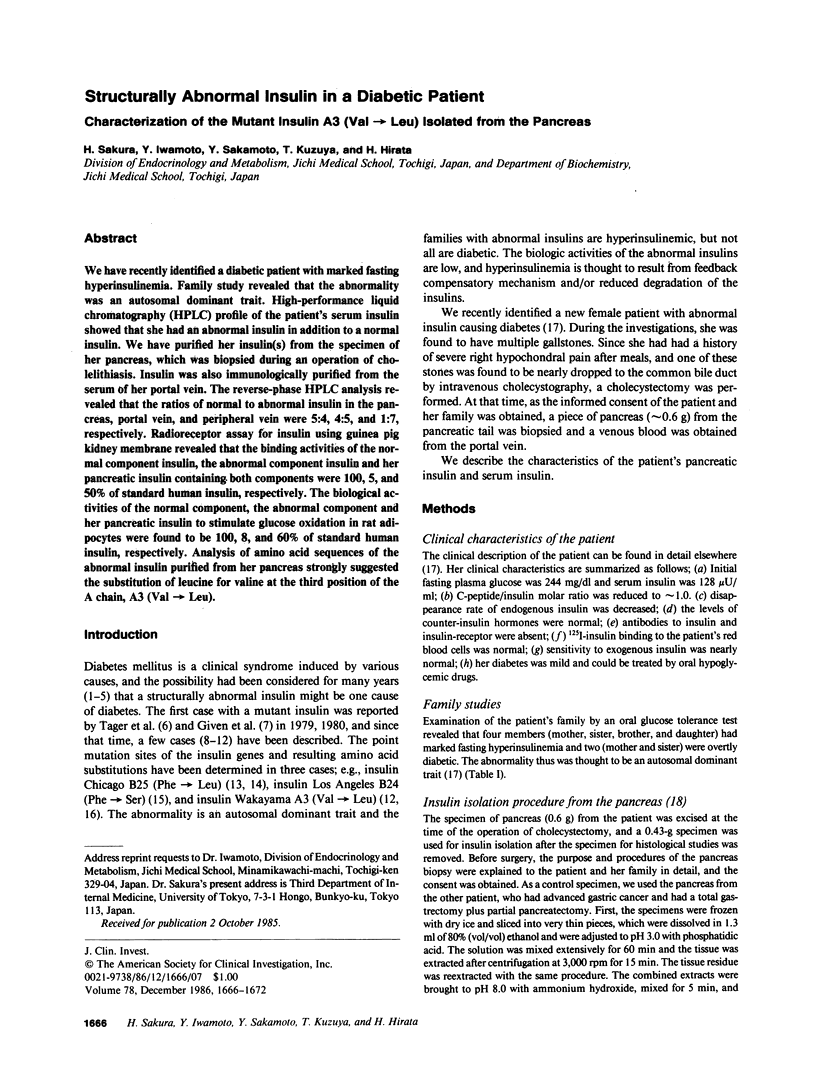
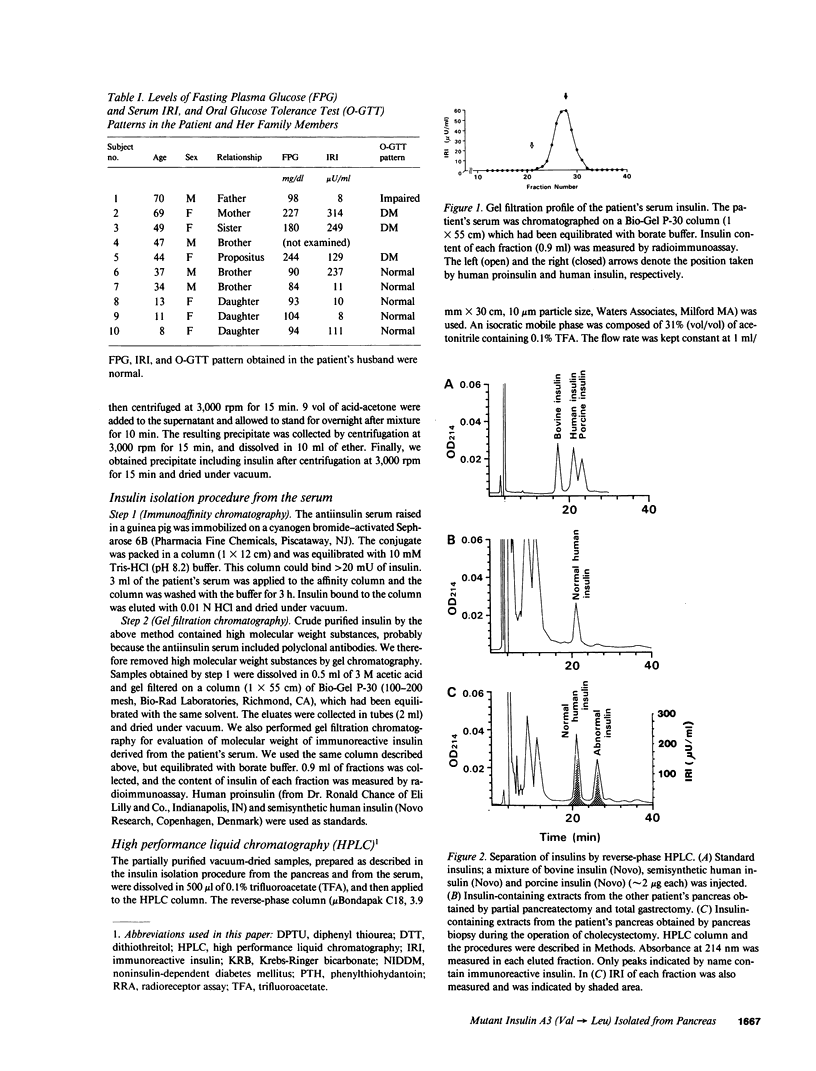
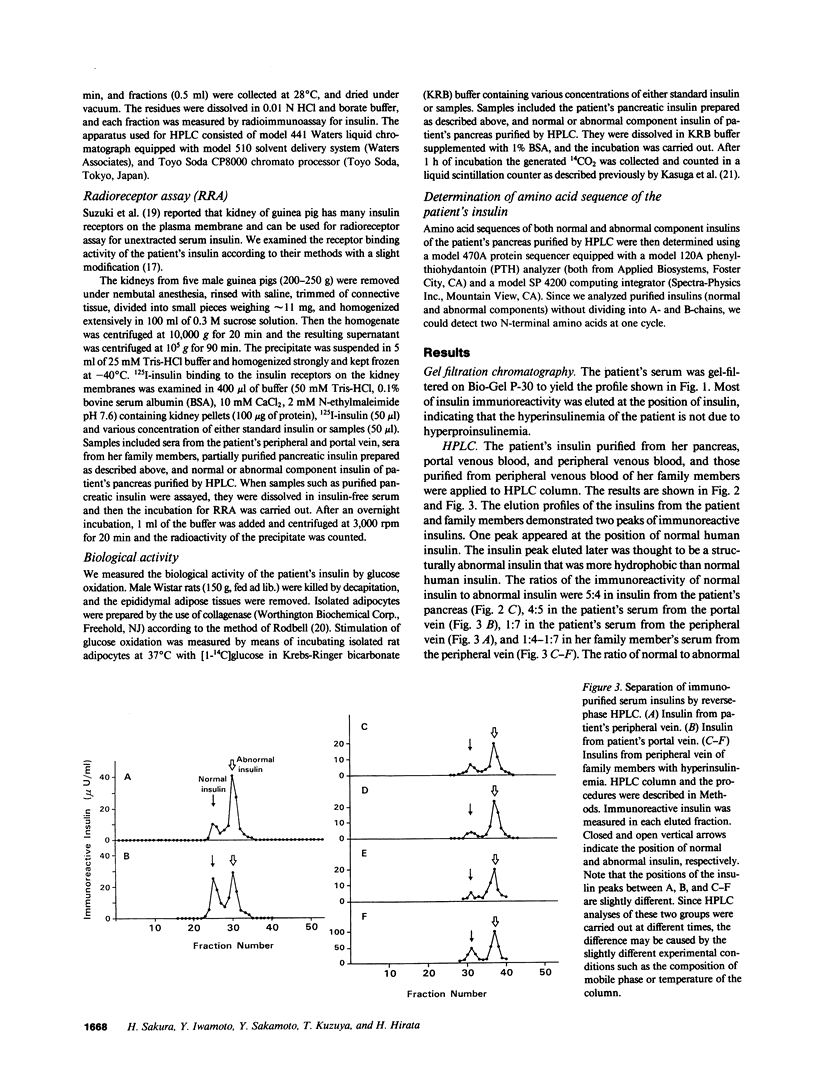
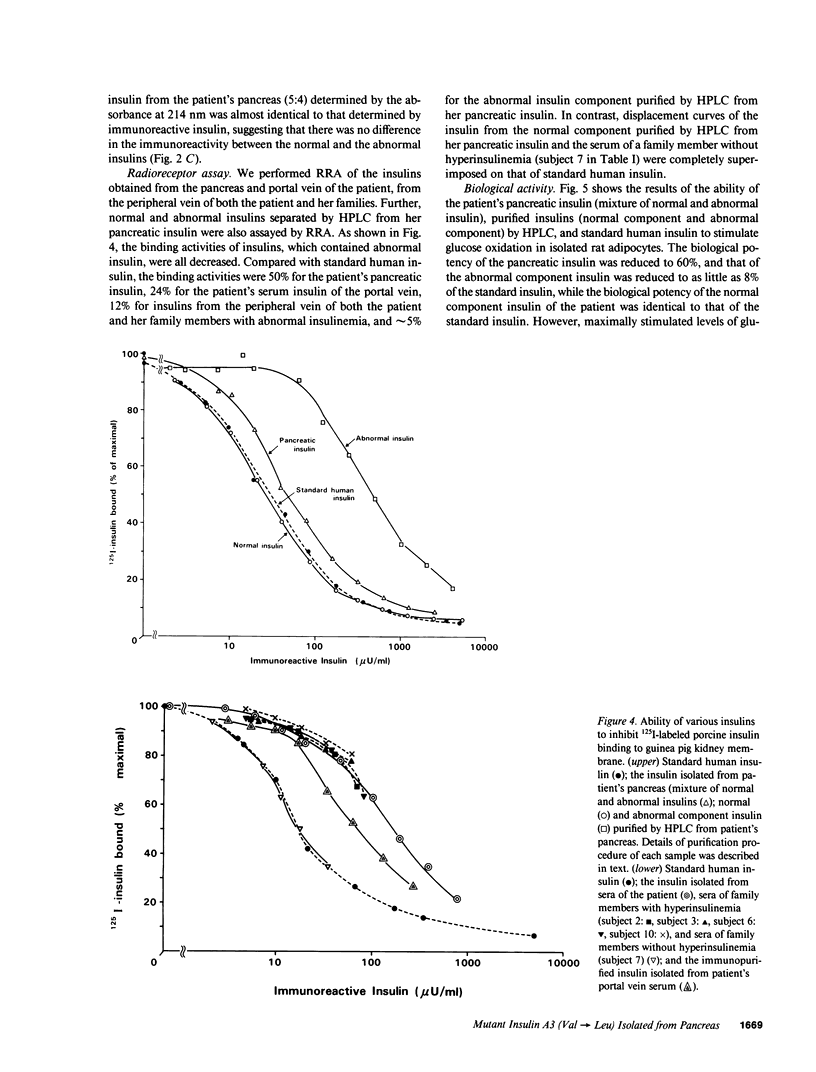
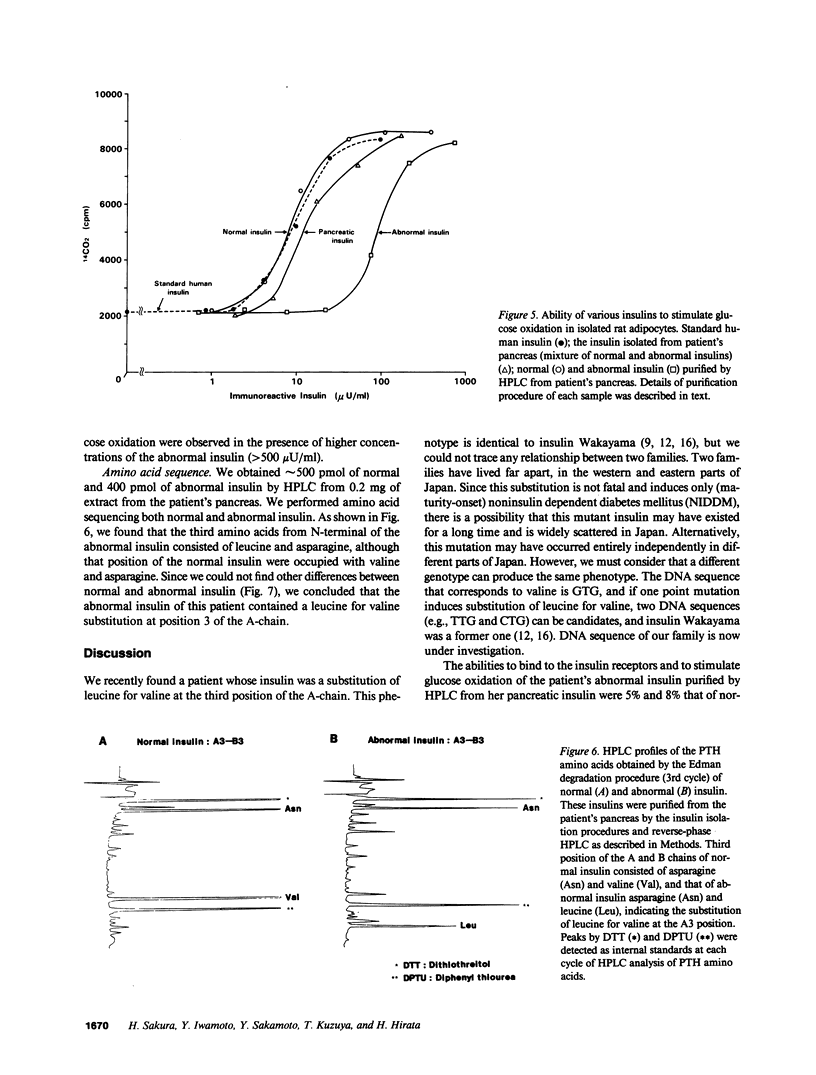
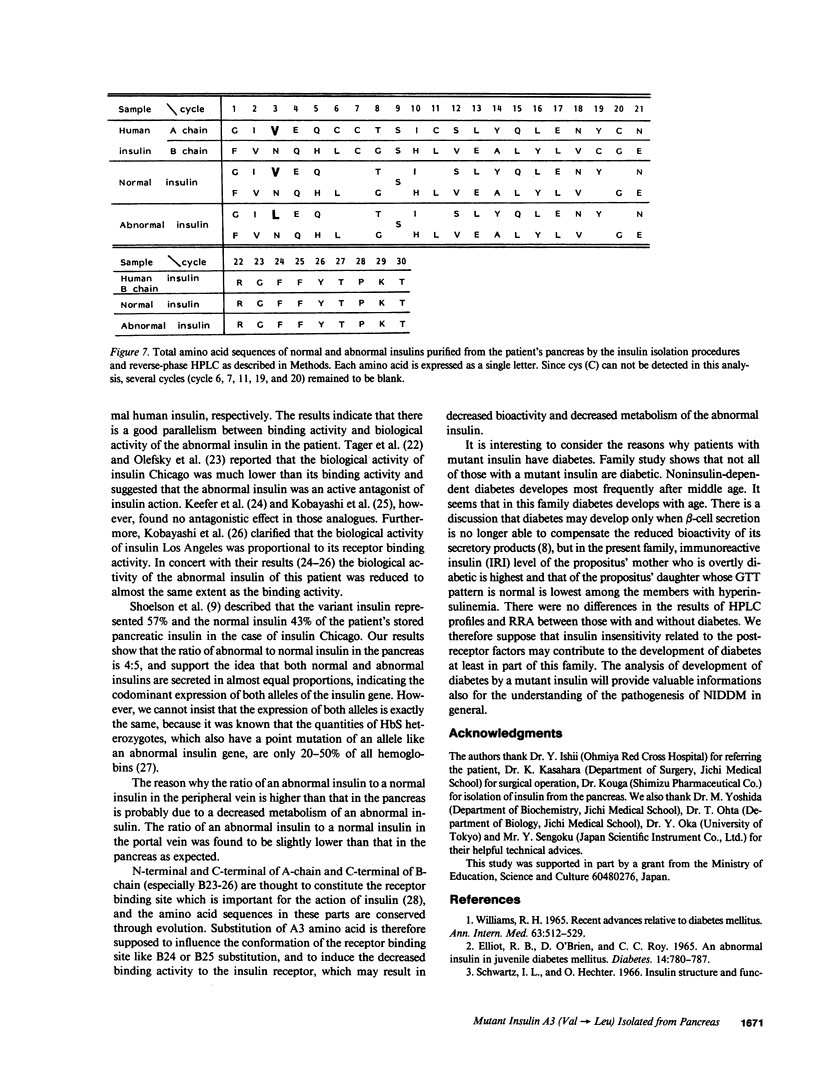
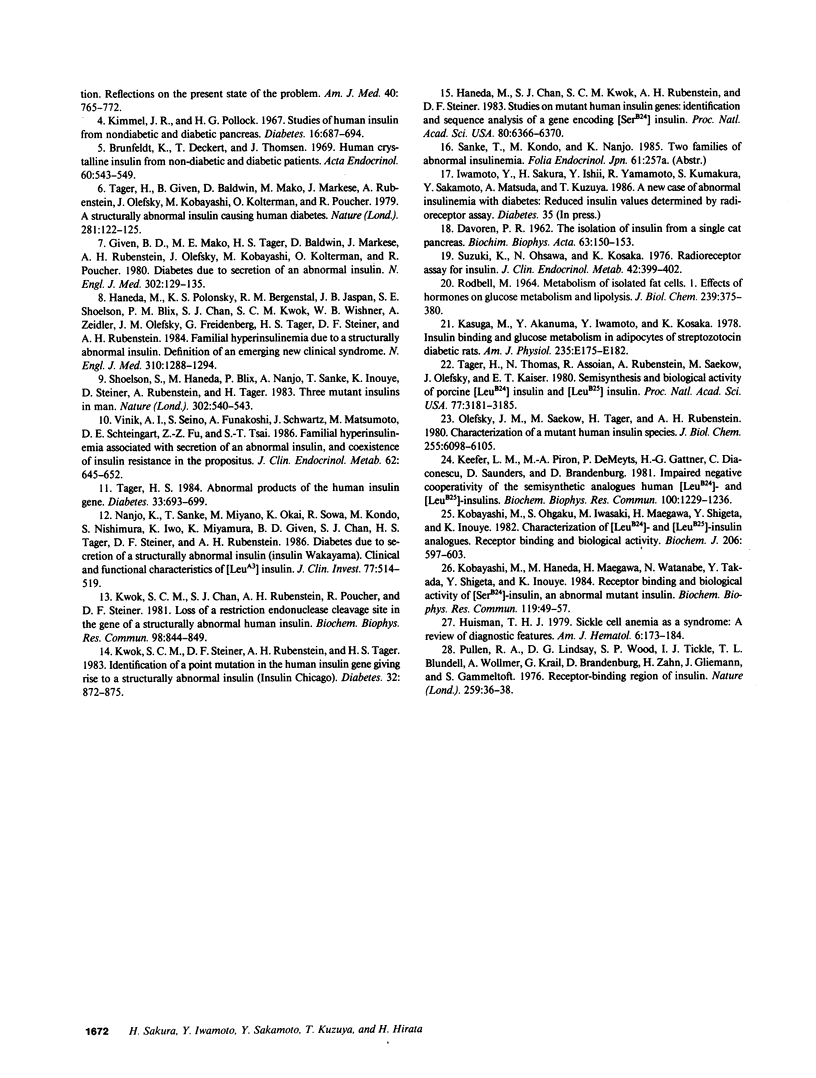
Selected References
These references are in PubMed. This may not be the complete list of references from this article.
- Brunfeldt K., Deckert T., Thomsen J. Human crystalline insulin from non-diabetic and diabetic patients. Acta Endocrinol (Copenh) 1969 Mar;60(3):543–549. doi: 10.1530/acta.0.0600543. [DOI] [PubMed] [Google Scholar]
- DAVOREN P. R. The isolation of insulin from a single cat pancreas. Biochim Biophys Acta. 1962 Sep 10;63:150–153. doi: 10.1016/0006-3002(62)90347-5. [DOI] [PubMed] [Google Scholar]
- Elliott R. B., O'Brien D., Roy C. C. An abnormal insulin in juvenile diabetes mellitus. Diabetes. 1965 Dec;14(12):780–787. doi: 10.2337/diab.14.12.780. [DOI] [PubMed] [Google Scholar]
- Given B. D., Mako M. E., Tager H. S., Baldwin D., Markese J., Rubenstein A. H., Olefsky J., Kobayashi M., Kolterman O., Poucher R. Diabetes due to secretion of an abnormal insulin. N Engl J Med. 1980 Jan 17;302(3):129–135. doi: 10.1056/NEJM198001173020301. [DOI] [PubMed] [Google Scholar]
- Haneda M., Chan S. J., Kwok S. C., Rubenstein A. H., Steiner D. F. Studies on mutant human insulin genes: identification and sequence analysis of a gene encoding [SerB24]insulin. Proc Natl Acad Sci U S A. 1983 Oct;80(20):6366–6370. doi: 10.1073/pnas.80.20.6366. [DOI] [PMC free article] [PubMed] [Google Scholar]
- Haneda M., Polonsky K. S., Bergenstal R. M., Jaspan J. B., Shoelson S. E., Blix P. M., Chan S. J., Kwok S. C., Wishner W. B., Zeidler A. Familial hyperinsulinemia due to a structurally abnormal insulin. Definition of an emerging new clinical syndrome. N Engl J Med. 1984 May 17;310(20):1288–1294. doi: 10.1056/NEJM198405173102004. [DOI] [PubMed] [Google Scholar]
- Huisman T. H. Sickle cell anemia as a syndrome: a review of diagnostic features. Am J Hematol. 1979;6(2):173–184. doi: 10.1002/ajh.2830060210. [DOI] [PubMed] [Google Scholar]
- Kasuga M., Akanuma Y., Iwamoto Y., Kosaka K. Insulin binding and glucose metabolism in adipocytes of streptozotocin-diabetic rats. Am J Physiol. 1978 Aug;235(2):E175–E182. doi: 10.1152/ajpendo.1978.235.2.E175. [DOI] [PubMed] [Google Scholar]
- Keefer L. M., Piron M. A., De Meyts P., Gattner H. G., Diaconescu C., Saunders D., Brandenburg D. Impaired negative cooperativity of the semisynthetic analogues human [LeuB24]- and [LeuB25]-insulins. Biochem Biophys Res Commun. 1981 Jun 16;100(3):1229–1236. doi: 10.1016/0006-291x(81)91955-0. [DOI] [PubMed] [Google Scholar]
- Kimmel J. R., Pollock H. G. Studies of human insulin from nondiabetic and diabetic pancreas. Diabetes. 1967 Oct;16(10):687–694. doi: 10.2337/diab.16.10.687. [DOI] [PubMed] [Google Scholar]
- Kobayashi M., Haneda M., Maegawa H., Watanabe N., Takada Y., Shigeta Y., Inouye K. Receptor binding and biological activity of [SerB24]-insulin, an abnormal mutant insulin. Biochem Biophys Res Commun. 1984 Feb 29;119(1):49–57. doi: 10.1016/0006-291x(84)91616-4. [DOI] [PubMed] [Google Scholar]
- Kobayashi M., Ohgaku S., Iwasaki M., Maegawa H., Shigeta Y., Inouye K. Characterization of [LeuB-24]- and [LeuB-25]-insulin analogues. Receptor binding and biological activity. Biochem J. 1982 Sep 15;206(3):597–603. doi: 10.1042/bj2060597. [DOI] [PMC free article] [PubMed] [Google Scholar]
- Kwok S. C., Chan S. J., Rubenstein A. H., Poucher R., Steiner D. F. Loss of a restriction endonuclease cleavage site in the gene of a structurally abnormal human insulin. Biochem Biophys Res Commun. 1981 Feb 12;98(3):844–849. doi: 10.1016/0006-291x(81)91188-8. [DOI] [PubMed] [Google Scholar]
- Kwok S. C., Steiner D. F., Rubenstein A. H., Tager H. S. Identification of a point mutation in the human insulin gene giving rise to a structurally abnormal insulin (insulin Chicago). Diabetes. 1983 Sep;32(9):872–875. doi: 10.2337/diab.32.9.872. [DOI] [PubMed] [Google Scholar]
- Nanjo K., Sanke T., Miyano M., Okai K., Sowa R., Kondo M., Nishimura S., Iwo K., Miyamura K., Given B. D. Diabetes due to secretion of a structurally abnormal insulin (insulin Wakayama). Clinical and functional characteristics of [LeuA3] insulin. J Clin Invest. 1986 Feb;77(2):514–519. doi: 10.1172/JCI112331. [DOI] [PMC free article] [PubMed] [Google Scholar]
- Olefsky J. M., Saekow M., Tager H., Rubenstein A. H. Characterization of a mutant human insulin species. J Biol Chem. 1980 Jul 10;255(13):6098–6105. [PubMed] [Google Scholar]
- RODBELL M. METABOLISM OF ISOLATED FAT CELLS. I. EFFECTS OF HORMONES ON GLUCOSE METABOLISM AND LIPOLYSIS. J Biol Chem. 1964 Feb;239:375–380. [PubMed] [Google Scholar]
- Schwartz I. L., Hechter O. Insulin structure and function. Reflections on the present state of the problem. Am J Med. 1966 May;40(5):765–772. doi: 10.1016/0002-9343(66)90158-6. [DOI] [PubMed] [Google Scholar]
- Shoelson S., Haneda M., Blix P., Nanjo A., Sanke T., Inouye K., Steiner D., Rubenstein A., Tager H. Three mutant insulins in man. Nature. 1983 Apr 7;302(5908):540–543. doi: 10.1038/302540a0. [DOI] [PubMed] [Google Scholar]
- Suzuki K., Ohsawa N., Kosaka K. Radioreceptor assay for insulin. J Clin Endocrinol Metab. 1976 Feb;42(2):399–402. doi: 10.1210/jcem-42-2-399. [DOI] [PubMed] [Google Scholar]
- Tager H. S. Lilly lecture 1983. Abnormal products of the human insulin gene. Diabetes. 1984 Jul;33(7):693–699. doi: 10.2337/diab.33.7.693. [DOI] [PubMed] [Google Scholar]
- Tager H., Given B., Baldwin D., Mako M., Markese J., Rubenstein A., Olefsky J., Kobayashi M., Kolterman O., Poucher R. A structurally abnormal insulin causing human diabetes. Nature. 1979 Sep 13;281(5727):122–125. doi: 10.1038/281122a0. [DOI] [PubMed] [Google Scholar]
- Tager H., Thomas N., Assoian R., Rubenstein A., Saekow M., Olefsky J., Kaiser E. T. Semisynthesis and biological activity of porcine [LeuB24]insulin and [LeuB25]insulin. Proc Natl Acad Sci U S A. 1980 Jun;77(6):3181–3185. doi: 10.1073/pnas.77.6.3181. [DOI] [PMC free article] [PubMed] [Google Scholar]
- Vinik A. I., Seino S., Funakoshi A., Schwartz J., Matsumoto M., Schteingart D. E., Fu Z. Z., Tsai S. T. Familial hyperinsulinemia associated with secretion of an abnormal insulin, and coexistence of insulin resistance in the propositus. J Clin Endocrinol Metab. 1986 Apr;62(4):645–652. doi: 10.1210/jcem-62-4-645. [DOI] [PubMed] [Google Scholar]
- WILLIAMS R. H. RECENT ADVANCES RELATIVE TO DIABETES MELLITUS. Ann Intern Med. 1965 Sep;63:512–529. doi: 10.7326/0003-4819-63-3-512. [DOI] [PubMed] [Google Scholar]


